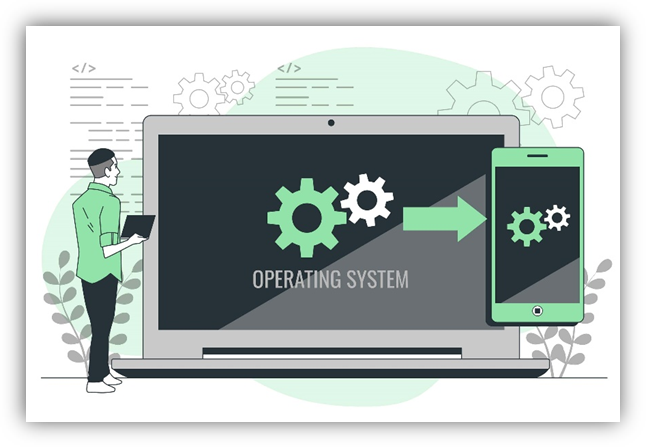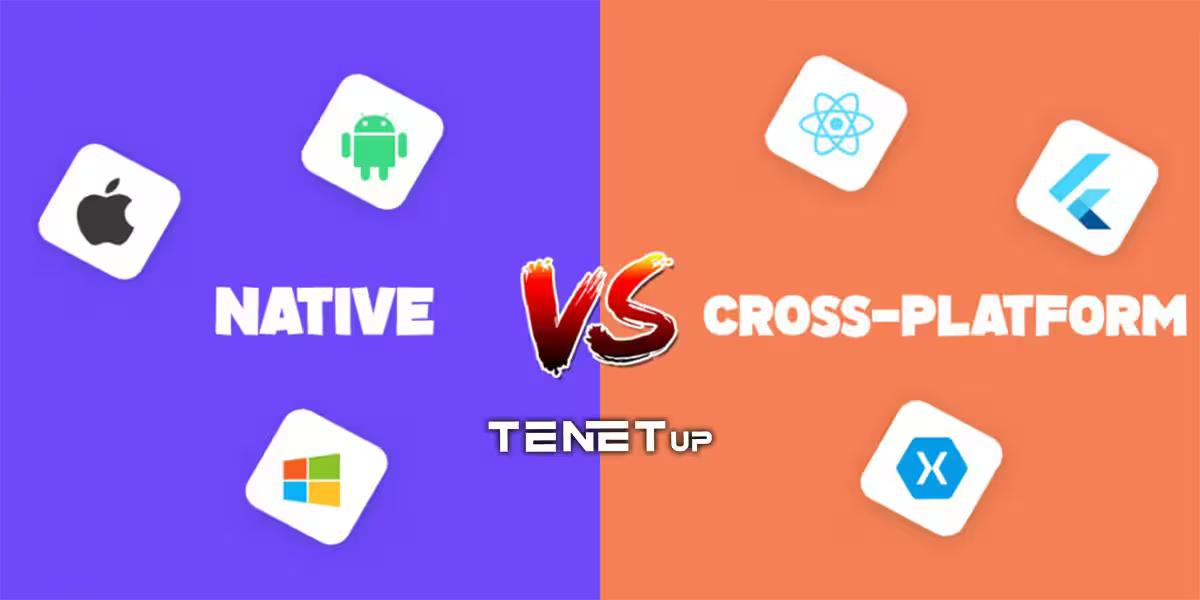"Challenges and Opportunities of Cross-Platform Software Development"
In the modern world of information technology, software and mobile application development is one of the fastest-growing and evolving domains. With a wide variety of devices and different operating systems available in the market, software developers strive to create diverse user experiences. In this context, the concept of "cross-platform" stands as one of the most important approaches, particularly in the realm of mobile app development.
Cross-Platform refers to the ability to develop an application or software in a way that it can run on multiple platforms or different devices. These platforms can include various mobile operating systems such as iOS (for Apple devices) and Android (for Android-based devices), as well as web and desktop devices. This means that a cross-platform application is capable of running uniformly or with minimal adjustments across all these platforms.
In this section of Tenetup, we will delve into the concept and significance of cross-platform development for applications. We will explore the advantages and disadvantages of this approach in detail, along with key considerations in cross-platform app development. Additionally, we will examine some successful examples of cross-platform applications.
Cross-Platform Programming Languages
Cross-platform programming languages can encompass a wide range of programming languages and frameworks that allow developers to build their applications in a multi-platform manner. Below are a few examples of these languages and frameworks:
- React Native
- Flutter
- Xamarin
- PhoneGap / Apache Cordova
- Unity
- Java
- Kotlin
- Swift
- HTML5
- JavaScript
It's also worth noting that some other development frameworks and tools like Apache Flutter and NativeScript are used to facilitate cross-platform app development. The choice of the appropriate language or framework for cross-platform app development depends on the project's requirements, features, and the developers' experience.

Pros and Cons of Cross-Platform Programming
Cross-platform development has its own set of advantages and disadvantages, which are discussed below:
Pros:
-
Cost and Time Savings: One of the most significant advantages of cross-platform programming is the reduction in development costs and time. By developing once for all platforms, there's no need to create separate codebases for iOS, Android, and other platforms, resulting in cost and time savings.
-
Reusable Code: In cross-platform programming, portions of code can be reused across all platforms, allowing changes and improvements to be applied universally and consistently.
-
Wider Market Reach: Cross-platform development enables you to simultaneously target different markets, including iOS, Android, web, and desktop, reaching a broader audience.
-
High Flexibility: Cross-platform programming provides developers with greater flexibility in choosing platforms and technologies and allows for easier changes to be made in projects.
Cons:
-
User Experience Quality: Cross-platform programming may lead to a reduction in the quality of the user experience for some platforms because different platforms have different design and behavioral standards.
-
Functional Limitations: Cross-platform programming may limit certain platform-specific features and capabilities, as it must accommodate common constraints across all platforms.
-
Larger and More Complex Code: In some cases, cross-platform development can result in larger and more complex codebases, which may pose challenges in terms of management and maintenance.
-
Dependency on Specific Tools: For cross-platform development, you may need to rely on specific frameworks and tools, which can impose limitations on your technology choices.
These pros and cons should be carefully considered when deciding whether to pursue cross-platform development for a project.

A Successful Example of a Cross-Platform Application
One of the successful examples of a cross-platform application is WhatsApp. WhatsApp is one of the most popular messaging applications worldwide and runs on various platforms, including mobile phones and tablets. The reasons for WhatsApp's success as a cross-platform application include:
-
Support for Multiple Platforms: WhatsApp was initially released for iOS and Android platforms, but developers gradually provided versions for web and desktop devices. This multi-platform support allows users to communicate and exchange messages across all their devices.
-
Consistency in User Experience: WhatsApp ensures a consistent user experience by maintaining uniform user interfaces and features across all platforms. This allows users to easily utilize all features and functionalities on all their devices.
-
Large User Base: WhatsApp is recognized as a highly popular messaging application with over a billion active users worldwide, making it one of the most essential communication apps globally.
-
Data Security and Privacy: WhatsApp uses message encryption to protect user security and privacy. This feature is of great importance and fosters user trust in the application.
-
Active Developers: WhatsApp provides developers, both individuals and companies, with the ability to easily create specialized versions of the app for various platforms. This flexibility enables the development of add-ons and new features within the application.
WhatsApp's success as a cross-platform application serves as a testament to the effectiveness of cross-platform development in reaching a wide and diverse user base.
Choosing Between Native, Hybrid, and Cross-Platform Development
In the realm of mobile app development, developers have three main options:
-
Native Apps: These are apps developed specifically for a single platform, such as iOS or Android, using platform-specific programming languages and tools.
-
Hybrid Apps: Hybrid apps are a combination of web technologies (HTML, CSS, JavaScript) and native code, allowing them to run on multiple platforms.
-
Cross-Platform Native Apps: These apps are developed using cross-platform frameworks and tools that allow code to be written once and deployed on multiple platforms while maintaining a native-like user experience.
The choice between these options depends on various factors, including project requirements, development resources, target audience, and desired platform coverage. Each approach has its own set of advantages and disadvantages, and developers must carefully evaluate these factors before making a decision.

Native Apps:
Native apps are developed using the platform-specific programming languages and tools of each respective platform. A developer can design an application for a specific operating system by utilizing the software development kit (SDK) and the native language supported by that platform. For example, to create an Android app, you would work with Java and the Android Studio environment, while for iOS, you would need expertise in Swift and the Xcode environment. If you intend to develop a Windows app, you should be proficient in the C# programming language and the Visual Studio environment.
Hybrid Apps:
Hybrid apps fall under the category of cross-platform development. With hybrid apps, you can access some of the native features of each platform using web technologies such as HTML, CSS, and JavaScript (the primary coding languages). The code of these apps can be made compatible with the target operating system using platform-specific SDKs.
Some of the well-known hybrid app development frameworks and tools include:
- PhoneGap
- Cordova
- Ionic
- Intel XDK
- Sencha
- Kendo UI
Cross-Platform Native Apps:
Cross-platform native apps are a type of mobile application developed using cross-platform frameworks and tools. These apps allow developers to write code once and deploy it on multiple platforms while still providing a native-like user experience. Unlike hybrid apps that often rely heavily on web technologies, cross-platform native apps aim to achieve a balance between code reusability and native performance.
Some of the key characteristics and advantages of cross-platform native apps include:
-
Single Codebase: Developers write a single codebase using a cross-platform framework, which is then compiled or transpiled to run on multiple platforms. This eliminates the need to maintain separate codebases for each platform.
-
Native-Like User Experience: Cross-platform native apps leverage native components and APIs, providing a user experience that closely resembles that of native apps. This results in better performance and a more seamless feel for users.
-
Cost-Efficiency: By sharing a codebase across platforms, development costs are reduced compared to building separate native apps for each platform.
-
Faster Development: Cross-platform frameworks often offer features like hot reloading, which accelerates the development and testing process.
-
Wider Reach: These apps can target multiple platforms, including iOS, Android, and sometimes even web and desktop, allowing developers to reach a broader audience.
Some popular cross-platform native app development frameworks and tools include:
- React Native
- Flutter
- Xamarin
- NativeScript
Each of these frameworks has its own strengths and ecosystem, and developers can choose the one that best suits their project requirements and expertise.

Conclusion
In conclusion, cross-platform development presents its own set of challenges and opportunities in software development. On one hand, it enables faster development and deployment across multiple platforms, leading to reduced costs and development time. On the other hand, accommodating the different features and user experiences of various platforms can pose challenges and potentially compromise the quality of the user experience.
Considering the continuous technological advancements and changing market demands, cross-platform development is likely to play a significant role in the future of software development. However, developers must carefully assess the challenges and opportunities of this approach and make use of appropriate tools and frameworks. Factors such as security, user experience, and flexibility should be taken into account when selecting and utilizing cross-platform solutions. Ultimately, with a deep understanding of the pros and cons of cross-platform development, developers can make better decisions in shaping the future of their software projects.
With Tenetup, what you envision for your future begins today!


